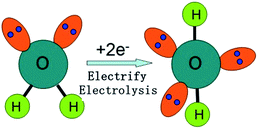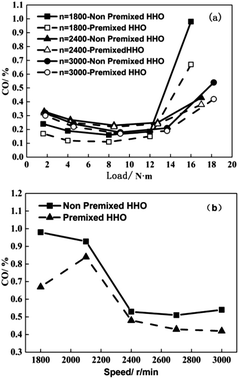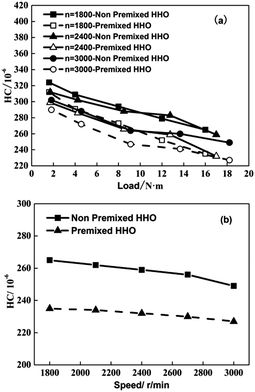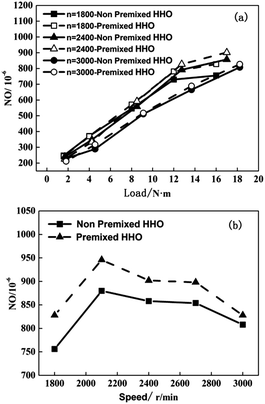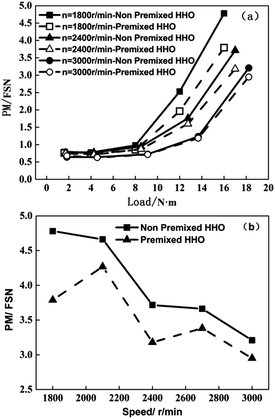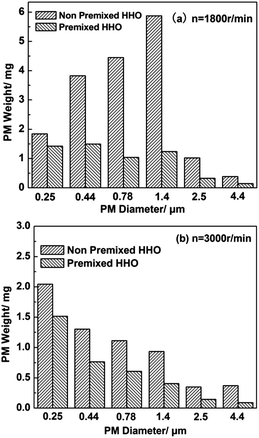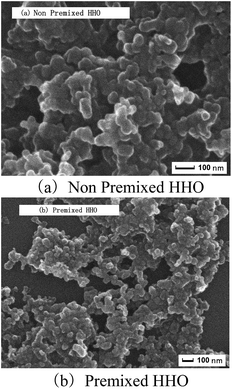Effects on emissions of a diesel engine with premixed HHO
S. Liu*,
Z. Wang,
X. X. Li,
Y. Zhao and
R. N. Li
School of Automobile and Traffic Engineering, Jiangsu University, Xuefu Road No. 301, Zhenjiang, Jiangsu Province, China
First published on 25th February 2016
Abstract
Most parts of China suffer often from haze pollution, which has a huge impact on human health. Road traffic has made the largest contribution to the haze. Of all the kinds of vehicular systems, the diesel engine produces the most PM; therefore, to reduce haze pollution, it is necessary research methods to reduce the PM produced by diesel engines. HHO (Brown's gas, Rhode's gas and HRG) is formed from H2 (60.79%) and O2 (30.39%) as well as a small amount of water vapour and active substances, such as oxygen radicals (O) and hydroxyl radicals (OH), which have quite strong oxidizing properties in the engine process, stimulating the C–H chain reaction during the combustion period and accelerating the oxidation of HC, CO and PM emissions as a result. The influence of blending HHO with diesel on diesel engine emission characteristics is well-researched, based on an 186FA single-cylinder diesel engine. The HHO was combined with air in the intake pipe. The influence of HHO on the amount of CO, HC, NO and PM emissions was analysed by collecting data under various speeds and loads. Through MOUDI, particles of various diameters under the highest torque working conditions and declared working conditions were collected to analyse how HHO affected the particle mass distribution in different diameter ranges. The analysis showed that when the speed was stable, the quantities of CO, HC and PM created were decreased by adding HHO; in addition, HHO had the greatest effect on PM. As the load increased, the amount of CO, HC and smoke declined gradually, but the decline of NO was smaller comparatively. Moreover, after blending with HHO, the quantity of NO created increased by 9.52% when the diesel engine operated according to external characteristics, and the quantity of HC, CO and PM created decreased by 31.6%, 11.3% and 20.71%, respectively. Finally, the gross mass of the particles dropped 67.48% and 42.53% under the highest torque working conditions and declared working conditions, respectively, with the distribution of diameters moving to smaller sizes. Introducing HHO into diesel can effectively reduce the generation of PM, which plays a positive role in reducing haze pollution.
1 Introduction
The diesel engine is widely used around the world as a power unit. Compared with other kinds of engines, it has good power performance and fuel economy to meet the needs of various machines. However, PM (particulate matter) is a big problem for the diesel engine.1–3 There are many ways to reduce PM. Introducing HHO (Brown's gas, Rhode's gas and HRG) as an additive into the diesel engine can change the combustion progress and has a significant effect on the emissions of CO, HC and PM.4–6 As is well-known, most parts of China suffer from haze pollution, and some individual regions have suffered from haze pollution for a long time. A hazy environment causes respiratory disease and even leads to lung cancer. Studies have shown that road traffic makes the largest contribution to the haze in China. Of all the kinds of traffic tools, the diesel engine produced the most PM. HHO can reduce the emission of PM. We conducted research to study how HHO influences the quantity and volume of PM emissions produced by a diesel engine and to analyse the change in NO, HC and CO and other conventional pollutants of diesel engines with the addition of HHO.Researchers around the world have focused on the diesel engine with premixed HHO for many years. In the 1970s, an Australian professor named Yull Brown proposed an HHO generator. HHO7 is essentially oxygen O2 and hydrogen H2 with the molar ratio 2![[thin space (1/6-em)]](https://www.rsc.org/images/entities/char_2009.gif) :
:![[thin space (1/6-em)]](https://www.rsc.org/images/entities/char_2009.gif) 1, which can be produced by electrolyzing alkaline solutions in an electrolytic tank. There are some hydroxyl free radicals included in HHO, which catalyse combustion and increase combustion efficiency. After that, scholars abroad started researching how to apply HHO to engines. Ammar A.7,8 studied the Honda G200 single cylinder gasoline engine to analyse the impact of HHO on its emission performance. The results showed that NOx was reduced approximately 50% and CO was reduced approximately 80% by introducing HHO gas into the engine. S. Bari9 studied a 4-cylinder diesel engine. The results showed that, with HHO, the engine's absolute effective efficiency increased 2.9% and the effective fuel consumption rate reduced 8.1%. HC, CO2 and CO were reduced as the rate of HHO increased, but the NOx was increased a little. Adrian Birtas10 and his collaborators studied diesel engines to research the impact of HHO on diesel engines' economic efficiency and emission performance. Their results showed that the absolute effective efficiency of diesel engines decreased approximately 0.8%. Under low load conditions, by introducing a small proportion of HHO, the emission of NOx decreased. As the proportion of HHO increased, CO and CO2 continuously decreased, and the PM decreased 30% at most. Ali Can Yilmaz11 and his collaborators also studied the impact of HHO on the performance and emissions of diesel engines. The result showed that, after introducing HHO, the emission of CO decreased 13.5% and HC decreased 5%.
1, which can be produced by electrolyzing alkaline solutions in an electrolytic tank. There are some hydroxyl free radicals included in HHO, which catalyse combustion and increase combustion efficiency. After that, scholars abroad started researching how to apply HHO to engines. Ammar A.7,8 studied the Honda G200 single cylinder gasoline engine to analyse the impact of HHO on its emission performance. The results showed that NOx was reduced approximately 50% and CO was reduced approximately 80% by introducing HHO gas into the engine. S. Bari9 studied a 4-cylinder diesel engine. The results showed that, with HHO, the engine's absolute effective efficiency increased 2.9% and the effective fuel consumption rate reduced 8.1%. HC, CO2 and CO were reduced as the rate of HHO increased, but the NOx was increased a little. Adrian Birtas10 and his collaborators studied diesel engines to research the impact of HHO on diesel engines' economic efficiency and emission performance. Their results showed that the absolute effective efficiency of diesel engines decreased approximately 0.8%. Under low load conditions, by introducing a small proportion of HHO, the emission of NOx decreased. As the proportion of HHO increased, CO and CO2 continuously decreased, and the PM decreased 30% at most. Ali Can Yilmaz11 and his collaborators also studied the impact of HHO on the performance and emissions of diesel engines. The result showed that, after introducing HHO, the emission of CO decreased 13.5% and HC decreased 5%.
This paper studies the 186F single-cylinder diesel engine and introduces HHO into the diesel engine to research the impact of HHO on the emissions of CO, HC, NO, and FSN under different rotation speeds or loads and to study the impact on PM with a MOUDI particle classification sampling device.
2 The impact of HHO on combustion
HHO is colourless and tasteless. The results of a study by the Dublin Adsorption Laboratory showed that the molar mass of HHO is 12.3 g mol−1. HHO is mainly made up of H2 and O2, with H2 accounting for 60.79%, O2 accounting for 30.39%, and a small amount of water vapour, O, OH and some other active substances accounting for the rest.12 The energy stored in 1 Lof HHO is approximately 600 J (±34 J). HHO is unstable, and its lifetime is approximately 11 minutes.13 After the active substances of HHO disappear, what remains is the combination gas of common H2 and O2, with a volumetric proportion of 2![[thin space (1/6-em)]](https://www.rsc.org/images/entities/char_2009.gif) :
:![[thin space (1/6-em)]](https://www.rsc.org/images/entities/char_2009.gif) 1.
1.
According to Eckman,13 the common water molecule includes two hydrogen atoms and one oxygen atom. The hydrogen atoms and the oxygen atom connect to each other by bonding electrons; meanwhile, the molecule interacts with another pair of electrons, forming a tetrahedral structure in space as showed in Fig. 1. A Rydberg cluster can be formed by electrolyzing water, whose main ingredients are H2 and O2 and also includes linear water molecules, which stay in a state of high energy with a trigonal bipyramidal shape, hydrogen atoms, free electrons, and several kinds of free radicals. As research on free radicals continues, the conclusion that OH can be generated by electrolyzing water also confirms that HHO includes a small quantity of free radicals.14,15
OH is a kind of nonselective oxide, and its oxidability is only less than F2. Of all the reactive oxygen free radicals, OH is regarded as the one with the strongest activity, playing the main role.16 It can easily oxidize almost all of the organic and inorganic pollutants with high oxidation efficiency and reaction speed. Although its lifetime is short, its reaction is so powerful that the action radius is approximately 5–10 times its molecular diameter, even having great influence on the adjacent molecules.17
Introduce HHO into a diesel engine and kindling it to cause an implosion forms a vacuum and negative pressure with the ratio of 1860![[thin space (1/6-em)]](https://www.rsc.org/images/entities/char_2009.gif) :
:![[thin space (1/6-em)]](https://www.rsc.org/images/entities/char_2009.gif) 1, thereby improving the disturbance inside the cylinder of the diesel engine.18 The trace amounts of OH free radicals included in HHO have strong oxidizing properties, which is catalytic combustion, to promote the reaction of the C–H chain during combustion and increase the quantity of OH free radicals inside the cylinder, thereby improving the combustion of mixed flammable gas and the oxidization of the unburned HC, CO and PM.19
1, thereby improving the disturbance inside the cylinder of the diesel engine.18 The trace amounts of OH free radicals included in HHO have strong oxidizing properties, which is catalytic combustion, to promote the reaction of the C–H chain during combustion and increase the quantity of OH free radicals inside the cylinder, thereby improving the combustion of mixed flammable gas and the oxidization of the unburned HC, CO and PM.19
3 Test device and procedure
This paper studies the 186F single-cylinder diesel engine. The important technical parameters of this engine are shown in Table 1, and the schematic diagram of the test device is shown in Fig. 2. The main test devices are a G5020 five-gas analysis metre, anFBY-201 fully automatic filter-type smoke metre, and a Model 100 MOUDI particle classification sampling device.| Item | Parameter |
|---|---|
| Diesel engine type | 186F |
| Cylinder bore × Stroke/mm × mm | 86 × 70 |
| Compression ratio | 19 |
| Displacement/L | 0.406 |
| Rated power/kW | 5.7 |
| Rated speed/rpm | 3000 |
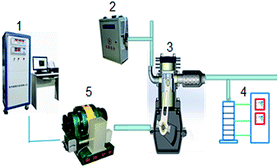 | ||
| Fig. 2 Schematic diagram of the test device. (1) Dynamometer control system; (2) HHO gas generator; (3) diesel engine; (4) MOUDI particle classification sampling device; (5) dynamometer. | ||
The generating means is the core component of the cell electrode material having a greater impact on energy consumption during electrolysis. The electrode plate material must be metal because H has good catalytic properties, a high melting point, and the number of outer electron atoms is 10.
The H2O to HHO generation process of the main raw material, at the point of the solution process, the cathode, H2, requires an anode to produce O2. H2O is a very weak electrolyte; at 25 °C it's theoretical conductivity is 5.5 × 10−6 s m−1. A strong electrolyte is needed to improve the conductivity of the electrolyte. Acid is a highly corrosive electrode, suitable as an electrolyte, in general, in a solution of NaOH or KOH as an electrolyte.
The results show that, for the free radicals in HHO, the survival time is short. The shale gas engine, in the course of its work, to maintain the activity of HHO connects the device into the trachea. Online means work occurs, and the resulting HHO occurs in the inlet with the page rock gas mixed with the mass flow through the control valve to adjust the shale gas blending ratio of HHO.
The Japanese Seiko JSM-7001F-type Scanning Electron Microscope and the JEM-2100-Type Transmission Electron Microscope are employed to record the particles' morphology and the structure of the particle samples before and after the blending and combustion with HHO. The scanning electron microscope has a resolution of 1.2 nm/3.0 nm, a minimum resolution of 1 nm and magnification of 10 to 800![[thin space (1/6-em)]](https://www.rsc.org/images/entities/char_2009.gif) 000 times. The transmission electron microscope has a magnification of 2000 to 1
000 times. The transmission electron microscope has a magnification of 2000 to 1![[thin space (1/6-em)]](https://www.rsc.org/images/entities/char_2009.gif) 500
500![[thin space (1/6-em)]](https://www.rsc.org/images/entities/char_2009.gif) 000 times, a point resolution of 0.23 nm and a lattice resolution of 0.14 nm. When observing, 20 visual fields are arbitrarily selected to obtain many particle projection pictures.
000 times, a point resolution of 0.23 nm and a lattice resolution of 0.14 nm. When observing, 20 visual fields are arbitrarily selected to obtain many particle projection pictures.
This study adopts two proposals for comparison. One is to introduce HHO into the cylinder at the speed of 2 L min−1 from the intake tube, and the other one is without HHO. Then, the emissions of HC, CO, NO and PM with different loads of 10%, 25%, 50%, 75% and 100% at different speeds of 1800 rpm, 2400 rpm and 3000 rpm are tested to analyse the effect of HHO on the diesel engine's emission under the conditions of different speeds and loads.
To check the effect of HHO on reducing PM, the exhaust will be introduced into the MOUDI particle classification sampling device with a vacuum pump. The PM will hit against a strike plate because of the influence of inertial airflow. The deeper the strike plate's position is, the smaller the strike plate's hole is. The speed of the airflow through the hole will be faster, while the diameter of the PM caught will be smaller. Different PM particles will be caught by different strike plates because of the different diameters of the particles. Under the condition of 100% load, the PM will be sampled before and after using HHO at different speeds of 1800 rpm and 3000 rpm, with a sample time of 20 min. We will measure the weight of PM caught by the different strike plates, perform the statistical calculations, and analyse the PM diameter distribution with and without HHO.
4 Test results and analysis
4.1 CO emission
Ammar20 studied the impact of premixed HHO on the Honda G200's emissions performance. The results showed that, by introducing a small amount of air into the engine after the HHO, HHO had a greater impact on CO emissions, which were reduced by approximately 80%.Fig. 3a shows the effect of HHO on CO emission under different loads at different speeds. It can be seen that CO is decreased in any working condition with HHO and that as the load increases, the falling range increases. The main reason for this is that HHO includes O2. Under high load conditions, the average temperature inside the cylinder is higher, and the O2 provides the vector for CO to be oxidized CO2.21
Fig. 3b shows the effect of HHO on CO emission at different speeds at 100% load. It can be seen that as the speed increases, the decrease of CO first decreases and then increases. At the speed of 1800 rpm, the decrease is the biggest, reaching 31.6%. The main influencing factor is the ratio of HHO in the total inlet during each circulation work. When the production speed of the HHO generator is set at 2 L min−1, the HHO will take approximately 0.53% (volume ratio) of the total circulation inlet air at the speed of 1800 rpm, and it will take 0.4% and 0.32% when the speed is 2400 rpm and 3000 rpm, reducing by 24.5% and 39.6% compared with 1800 rpm. The decreasing ratio of HHO causes its catalysis for mixed flammable gas to become lower.
According to Fig. 3b, when HHO is introduced, CO emission decreases 22.2% and 11.6% at the speeds of 2400 rpm and 3000 rpm, respectively, compared with the condition without HHO. The effect of HHO on reducing CO emission at the speed of 3000 rpm is better that at 2400 rpm. The main reason for this effect is that, with 100% load, the exhaust temperature is 456 °C and 541 °C at 2400 rpm and 3000 rpm. Therefore, the average combustion temperature inside the cylinder at 3000 rpm is higher, more OH free radicals emerge during combustion, and the oxidization of CO increases accordingly. This effect is why the decrease of CO emission at 3000 rpm is greater than at 2400 rpm.
4.2 HC emission
S. Bari9 studied the influence of premixed HHO on four-cylinder diesel engines. The results showed that, with the premixed HHO, the absolute maximum effective efficiency of the diesel increased by 2.9% and the highest fuel consumption was reduced by 8.1%. When a higher proportion of HHO was added, HC and CO were reduced.Fig. 4a shows the effect of HHO on HC emission under different loads at different speeds. It can be seen that HC is decreased in any working condition with HHO. The main reason is that the main component of HHO is H2, which does not consume extra O2 in the air during combustion. Additionally, H2 has the characteristics of a large diffusion coefficient, wide ignition limits, small ignition energy and fast flame propagation speed when burned.22 The introduced HHO increases ignition quantity and accelerates diffusive combustion. Moreover, with HHO, the fuel generates more OH free radicals during combustion, whose strong oxidizing properties promote the reaction with the C–H chain and continuously oxidize unburned HC after the main combustion period. Thus, HC emission is reduced.
Fig. 4b shows the effect of HHO on HC emission at different speeds under 100% load. It can be seen that the two curves of HC emission are almost parallel before and after HHO is introduced, so the effect of HHO on reducing HC emission is not influenced much by rotation speed. At the speed of 1800 rpm, the decrease of HC emission reaches its greatest, approximately 11.3%. At the speed of 3000 rpm, the decrease is the smallest, approximately 8.8%. The reason is that at the speed of 1800 rpm, HHO accounts for a larger proportion of the inlet air.
4.3 NO emission
Samuel23 studied the influence of HHO on the NOx emission performance of diesel engines. The results showed that when fed 1.5 L min−1 HHO, NOx emission concentrations decreased 17.9%. When fed 2.8 L min−1 premixed HHO, NOx emission concentrations rose.Fig. 5a shows the effect of HHO on NO emission under different loads at different speeds. It can be seen that HHO has no evident influence on NO emission under low load conditions. This is because under low load conditions, fuel delivery is less and the excess air coefficient is larger; therefore, the introduced HHO has less effect on the combustion of the mixed inflammable gas inside the cylinder.
When the load of the diesel engine is higher than 50%, after introducing HHO, the NO emission will be higher than for the working condition without HHO. The reason is that, as the load increases, fuel delivery also increases and the excess air coefficient inside the cylinder decreases. After HHO is introduced, the ignition quantity becomes greater, the diffusive combustion moves faster, and the maximum explosion pressure and temperature are higher. Moreover, HHO itself contains O2, which promotes the combustion of mixed inflammable gas more fully; therefore the temperature and pressure inside the cylinder are both a little higher than the condition without HHO, causing the increase in NO emissions.24
Fig. 5b shows the effect of HHO on NO emission at different speeds under 100% load. It can be seen that after HHO is introduced, as the speed increases, NO emission increases 9.52%, 7.50%, 5.13%, 5.15% and 2.48%, respectively; i.e., the effect of HHO on NO emission becomes lower. The reason is that, as the speed increases, the proportion of HHO decreases gradually, so the effect of HHO on combustion becomes weaker.
4.4 PM emission
Fig. 6a shows the effect of HHO on PM emission under different loads at different speeds. It can be seen that HHO has no evident influence on PM emission under low load conditions. This is because, under low load conditions, the fuel delivery is less and the excess air coefficient is larger, so less PM is generated. Therefore, PM changes little after HHO is introduced.25When HHO is introduced, as the load increases, the decrease in PM also increases. Under 100% load, the PM emission reaches its maximum value at any speed, and the effect of HHO on PM emission is also the most obvious. The possible reasons are as follows. Under 100% load, the fuel delivery reaches its maximum, and therefore the generated PM reaches its maximum. After HHO is introduced, the implosion effect of HHO promotes the disturbance and combustion inside the cylinder. During the PM oxidation phase, under high load the temperature inside the cylinder is higher, the speed of OH free radicals increases, and the high temperature environment is maintained longer, promoting the oxidation of PM. Therefore, under the high load condition, HHO has a more obvious effect on PM. Fig. 6b shows the effect of HHO on PM emission at different speeds under 100% load. Compared to high speed, PM decreases more significantly at the speed of 1800 rpm; the reduction rate is 20.71%. The main reason is that, at 1800 rpm HHO accounts for the largest proportion of the inlet air and the OH free radical included is the highest; therefore the effect on promoting combustion is the most obvious. The same is true for inhibiting and oxidizing PM.
4.5 PM diameter distribution
According to Fig. 7a and b, with HHO, as the speed increases, the PM diameter distribution becomes smaller. At the speeds of 1800 rpm and 3000 rpm, the decrease is 67.48% and 42.53, respectively, and the PM diameter distribution moves towards smaller sizes. The reason is that, as the speed increases, the average temperature inside the cylinder becomes higher, making the combustion more complete, so PM decreases. In addition, at high speed, the temperature of combustion inside the cylinder and at the exhaust are higher; during the after-combustion and exhaust period, the ratio of PM that is oxidized increases, larger particle sizes are oxidized into smaller ones, and smaller particle sizes are oxidized completely, causing the PM diameter distribution to move towards the smaller sizes. Because of the combined effect described above, the total weight of PM decreases.Preliminary studies suggest that this is mainly because the active radicals in HHO promote the oxidation of dissolved organic matter on particle surfaces, so that the viscosity on the particle surface decreases, reducing the probability of particle collision and agglomeration.26
4.6 PM appearance
Fig. 8 shows the morphology and structure of the particles before and after blending combustion with HHO. It is observed that the particles are approximately spherical, and through processes of collisions and coagulation, the particles intersect together to form distribution patterns of flocculence, bulk and chain. Compared with biodiesel particles, after blending combustion with HHO, particles in the forms of bulk and flocculence are fewer but are mainly distributed in the forms of chain and branch. Meshing is conducted by scanning electron microscopy images of each sample to obtain the number of particles per square centimetre; combined with the measurement capabilities in Digital Micrograph software, the number of particles finally obtained is the average of 20 fields of view for each sample. Calculations show that before and after blending combustion with HHO, the number of particles per unit area is 17.5 and 13.8, respectively, and compared with biodiesel, the number of particles is decreased by approximately 21.1%.Fig. 9 is a microcosmic structure chart of particles before and after blending combustion with HHO. It is observed that under the action of liquid bridges and solid bridges between the particles, the particle granules (i.e., secondary particles) are prepared by mutual bond and accumulation of the elementary particles in different sizes to form micelles having a fractal structure, showing different density levels at the junction, of which the darker area is the result of the superposition of a plurality of elementary particles. Further amplified by particle agglomerates, it is observed that the basic carbon particles are composed of a core and a shell, and the carbon layer structure of the shell is strongly similar to the microcrystalline structure of multilayer graphite with high stability; the closer to the core, the more obvious the torsion and translation phenomena between carbon layers will be, showing a highly disordered topography. Compared with the particles of biodiesel, after blending combustion with HHO, the stacking between the basic carbon particles is decreased, there is a larger gap between the various basic carbon particles, and the aggregate structure is looser. This is mainly because, in the combustion process with HHO, on the one hand the active radicals, such as OH, play the role in oxidizing the soluble organic matter on the particle surface, thereby reducing the stickiness of the particle surface and the probability of particle collision agglomeration; on the other hand, OH active radicals have the lowest reaction activation energy with particle precursors (benzene) with fast reaction speed, which has played a role in suppressing particle nucleation, reducing the generation of particles.
5 Conclusions
In this paper, the influence of blending HHO with diesel on diesel engine emission characteristics based on an 186FA single cylinder diesel engine was studied. HHO was combined with air in the intake pipe, and the influence of HHO on the amount of CO, HC, NO and PM emissions was analysed by collecting data under various speeds and loads. Through MOUDI, particles of various diameters under the largest torque working condition and declared working condition were collected to analyse how HHO affected the particle mass distribution in different diameter ranges. The main conclusions are as follows:After introducing HHO into the engine at the same speed but under low load with premixed HHO, the effect on emissions from the diesel engine is less. As the load increases, the increase of NO emission increases at an average rate of 5%. The decrease of CO, HC and PM emissions increases approximately 15%, 8.5% and 7.5%, respectively.
Under 100% load with HHO, as the speed increases, the increase of NO emission decreases at an average rate of 6%, the decrease of CO, HC and PM emissions decreases approximately 17.5%, 10%, 12%, respectively, and the weight of PM decreases 6.672 mg on average.
Under the conditions of 1800 rpm and 100% load, the effect of HHO on the emissions is the most obvious, with NO increasing 9.52%, and CO, HC, PM decreasing 31.6%, 11.3%, 20.71%, respectively, PM weight decreasing 11.766 mg, and the PM diameter distribution moving towards smaller particle sizes.
When the diesel engine is working, the surface morphology of the particles is predominantly distributed in lump, chain and arborescence and so on, and after the blending combustion with HHO, the lump structure is reduced and the particles are mostly distributed in chain and arborescence, and the number of particles per unit area is reduced.
To sum up, after introducing HHO into the diesel engine, although NO emissions increased, CO, HC and PM were effectively reduced. Among them, PM is reduced the most. PM reduction plays an active role in reducing haze pollution, which can improve the quality of China's environment, which is good for human health. After introducing HHO into the engine at low speed under high load, the reduction effect on PM is most obvious. Because this kind of condition is most frequently used in road traffic conditions, HHO can be promoted as suitable to be applied in diesel engines.
Acknowledgements
This study was financially supported by the National Natural Science Foundation of China under Grant (No. 51376083), the Natural Science Foundation of Jiangsu Higher Education Institutions Project (No. 13KJA470001), and the Jiangsu Higher Education Graduate Research Innovation Projects (No. CXZZ13_0672 and No. KYLX_1035).Notes and references
- Y. J. Qian and C. J. Zuo, Test study on combustion in ZS195 diesel engine blended with hydrogen, Tractor & Farm Transporter, 2010, 37(5), 55–59 Search PubMed.
- C. Liang and C. W. Ji, An experimental study on the effects of hydrogen addition on the combustion and emissions of a diesel engine, Automot. Eng., 2009, 31(7), 669–673 Search PubMed.
- C. M. Pecoraro, M. Santamaria, P. Bocchetta and P. D. Quarto, Influence of synthesis conditions on the performance of chitosan–heteropolyacid complexes as membranes for low temperature H2–O2 fuel cell, Int. J. Hydrogen Energy, 2015, 1–11 Search PubMed.
- R. B. Durairaja, J. Shanker and M. Sivasankar, HHO gas with bio diesel as a dual fuel with air preheating technology, International Conference on Modelling Optimization and Computing, 2012, 38, 1112–1119 Search PubMed.
- R. M. Santilli, A new gaseous and combustible form of water, Int. J. Hydrogen Energy, 2006, 31, 1113–1128 CrossRef CAS.
- Y. C. Song and Z. Ning, Numerical simulation of NOx and particulate emission characteristics of hydrogen/diesel engine, Trans. CSICE, 2011, 29(6), 495–503 CAS.
- A. A. Al-Rousan, Reduction of fuel consumption in gasoline engines by introducing HHO gas into intake manifold, Int. J. Hydrogen Energy, 2012, 37, 12040–12042 CrossRef CAS.
- S. A. Musmar and A. A. Al-Rousan, Effect of HHO gas on combustion emissions in gasoline engines, Fuel, 2011, 90, 3066–3070 CrossRef CAS.
- S. Bari and M. M. Esmaeil, Effect of H2/O2 addition in increasing the thermal efficiency of a diesel engine, Fuel, 2010, 89, 378–383 CrossRef CAS.
- B. Adrian, I. Voicu, C. Petcu and R. Chiriac, et al., The effect of HRG gas addition on diesel engine combustion characteristics and exhaust emissions, Int. J. Hydrogen Energy, 2011, 36, 12007–12014 CrossRef.
- C. Y. Ali, U. Erinç and A. Kadir, Effect of hydroxyl (HHO) gas addition on performance and exhaust emissions in compression ignition engines, Int. J. Hydrogen Energy, 2009, 35, 11366–11372 Search PubMed.
- M. S. Ruggero, A new gaseous and combustible from of water, Int. J. Hydrogen Energy, 2006, 31, 1113–1128 CrossRef.
- C. Eckman, Plasma orbital expansion of the electrons in water, Natural Philosophy Alliance Proceedings, 2010, 7, 142–144 Search PubMed.
- X. Y. Li, F. Ding, P. S. Y. Lo and S. H. P. Sin, Electrochemical disinfection of saline wastewater effluent, J. Environ. Eng., 2002, 128, 697–704 CrossRef CAS.
- S. Lecour and B. B. Abdellah, Demonstration of the production of oxygen-centered free radicals during electrolysis using E.S.R spin-trapping techniques: effects on cardiac function in the isolated rat heart, Free Radical Biol. Med., 1998, 24, 573–579 CrossRef CAS PubMed.
- J. M. McCord, Oxygen-derived free radicals in postischaemic tissue injury, N. Engl. J. Med., 1985, 312(3), 159–163 CrossRef CAS PubMed.
- M. White, R. Steeper and E. Lutz, The hydrogen-fueled internal combustion engine: a technical review, Int. J. Hydrogen Energy, 2006, 31, 1292–1305 CrossRef.
- Z. Nan, G. M. Wei, X. H. Dong, N. W. Ling and S. W. Tong, The fluorescence detection of glutathione by ˙OH radicals' elimination with catalyst of MoS2/rGO under full spectrum visible light irradiation, Talanta, 2015, 144, 551–558 CrossRef PubMed.
- C. Ramanjaneyulu and B. Rajakumar, Kinetic parameters for the reaction of OH radical with cis-CHF
![[double bond, length as m-dash]](https://www.rsc.org/images/entities/char_e001.gif) CHCHF2, trans-CHF
CHCHF2, trans-CHF![[double bond, length as m-dash]](https://www.rsc.org/images/entities/char_e001.gif) CHCHF2, CF2
CHCHF2, CF2![[double bond, length as m-dash]](https://www.rsc.org/images/entities/char_e001.gif) CHCHF2 and CF2
CHCHF2 and CF2![[double bond, length as m-dash]](https://www.rsc.org/images/entities/char_e001.gif) C
C![[double bond, length as m-dash]](https://www.rsc.org/images/entities/char_e001.gif) CHF: hybrid meta DFT and CVT/SCT/ISPE calculations, J. Fluorine Chem., 2015, 178, 266–278 CrossRef CAS.
CHF: hybrid meta DFT and CVT/SCT/ISPE calculations, J. Fluorine Chem., 2015, 178, 266–278 CrossRef CAS. - S. A. Musmar and A. A. Al-Rousan, Effect of HHO gas on combustion emissions in gasoline engines, Fuel, 2011, 90, 3066–3070 CrossRef CAS.
- Y. H. Ftwi, A. Rashid, A. Aziz and S. A. Sulaiman, Methane enrichment of syngas (H2/CO) in a spark-ignition direct-injection engine: combustion, performance and emissions comparison with syngas and compressed natural gas, Energy, 2015, 1–10 Search PubMed.
- Z. Y. Zhen, Y. C. Chao, J. W. Li and H. Yan, Effects of H2 addition on combustion and exhaust emissions in a diesel engine, Fuel, 2015, 139, 190–197 CrossRef.
- Samuel S. and Mccormick G., Hydrogen enriched diesel combustion, SAE Paper, No. 2010-01-2190.
- C. Hyoseok, E. Taejun, S. Soonho and M. C. Kwang, An experimental study on the fuel conversion efficiency and NOx emissions of a spark-ignition gas engine for power generation by fuel mixture of methane and model syngas (H2/CO), J. Nat. Gas Sci. Eng., 2015, 23, 517–523 CrossRef.
- B. Rahul, R. Sumit and K. B. Probir, Hydrogen-EGR synergy as a promising pathway to meet the PM–NOx–BSFC trade-off contingencies of the diesel engine: a comprehensive review, Int. J. Hydrogen Energy, 2015, 40, 12824–12847 CrossRef.
- P. Geng, H. Zhang and S. C. Yang, Experimental investigation on the combustion and particulate matter (PM) emissions from a port-fuel injection (PFI) gasoline engine fueled with methanol-ultralow sulfur gasoline blends, Fuel, 2015, 145, 221–227 CrossRef CAS.
| This journal is © The Royal Society of Chemistry 2016 |

